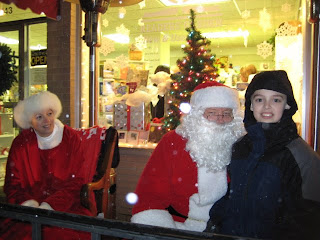Notes From My Knapsack 12-18-08
Jeff Gill
Toys In a Less Than Playful Time
With the economic downturn, and retail sales down five months running, I know stores and shop owners are nervously watching their sales this Christmas season. That three percent growth that we keep hearing is a baseline for a healthy economy makes me wonder what a healthy economy is by their definition.
Still, there’s that whole tradition of gift giving that the Magi got started with their dratted myrrh, gold, and frankincense, and the children expect something under the tree.
Between the recession on steroids and a kind of retreat into nostalgia that times like these promote, we’re seeing less of the hip, cutting edge, high tech look for what is the ad world’s normative seasonal atmosphere, and more knit mufflers and carolers and even the stray top hat and lantern.
What would happen if we got really all throwbacky about Christmas for the kids? The Granville Historical Society had a set of old-timey tools out for the Candlelight Walking Tour which generated a great deal of conversation on the streets about rug beaters and sugar shears and all those things labor saving devices were invented to save us from. But what about toys?
Somehow the standard street scene meant to holler out to us “olden times” in movies has come to include a lad in knickers with a hoop and stick. Currier and Ives put this young fellow in a number of their atmospheric scenes, and whether in old engravings or today’s TV programs, you get the impression that this was all the rage at some indeterminate point, long ago but recently enough to have metal barrel hoops.
I can’t find a reference that tells me if children got a hoop with a special stick for a present, or if it was more like kids playing with the cardboard box Christmas afternoon. A found toy, perhaps, but what an interesting toy for today, promoting getting outside, aerobic activity, and hand-eye co-ordination? (The Lad says “No, it isn’t.”)
Those of you who loved “A Christmas Story” (25 years last month, with the house in Cleveland now a delightfully kitschy shrine – see www.achristmasstoryhouse.com, and you can search my knapsack.blogspot.com site for photos from there, see archives at right, scroll down) remember the Red Ryder BB gun, which I still can’t recommend: you’ll shoot your eye out!
But there was a prequel made later, with a different cast yet the same names, Jean Shepherd narrating, and filmed at that house again, called “My Summer Story.” The plot anchor here is not an air rifle, but a fighting top.
Yes, a greatly desired and fondly hoped for gold painted top that you tossed with a pull string. If it looks easy, try it sometime; cracking a whip is easier. I played with one, with grim intent, over at Ohio Village years ago, and the movie makes group play with them look like marbles with attitude.
Dolls are a whole ‘nother category of then vs. now. In keeping with laws first outlined in “Brave New World,” no new toy can be released, apparently, without being more complicated and feature-ridden than their predecessor.
Try to find a doll that is warm, soft, well stitched, and without any Velcro pockets for batteries, voice recorder devices, or embedded aliens to burst from Betsy-Wetsie’s chest (you thought excreting baby dolls were bad). They do exist, but they are well hidden. If the voice and posture and activities are to be supplied by the owner from her or his own imagination, you’ll not find them on the front shelves in the larger stores.
This isn’t just to idealize corn husk dolls – my brother and I loved to play with some rubber figures with internal wires in what was a high-techy play set for the late 60s, Maj. Matt Mason and Sgt. Storm. I looked on-line to see if I could recover a bit of our childhood for both of us, and wow . . .
If we still had ours, and they were in good shape, let alone in original packaging, they . . . just go look at eBay and marvel. They’re worth something, but apparently (gulp) as antiques. Our guys lived full and active lives before vanishing into wherever their tattered bodies and plastic parts ended up. (I didn’t buy him any; he couldn’t let his girls touch them for what they cost now anyhow.)
But for those few fellow astronaut toy fans out there, consider this – Jeff Long just beat Matt Mason for President!
Jeff Gill is a writer, storyteller, and supply preacher around central Ohio; send him a word at knapsack77@gmail.com.
PS - If you're having trouble remembering Major Matt Mason, but think it rings a faint bell, here's the line's 1969 Christmas ad, which has it all (i think my brother and i had about half of it all between us):
























